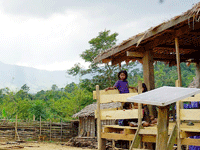Village life goes electric via government, partner efforts
Working together to find solutions to supply electricity to off-grid communities with the government and UNDP.
Cooperation with international organisations and boosting infrastructure in poor villages are among the measures adopted by the Lao government to move the nation out of the list of least developed countries (LDCs).
Kabong village of Nakai district in Khammuan province is among a number of villages without access to electricity, and the government and international organisations are jointly trying to find solution to help the people.
 |
| The government and UNDP are working together to provide electricity to off-grid communities. --Photos UNDP Laos/ Ildiko Hamos-Sohlo |
According to a report from the United Nations Development Programme (UNDP), Kabong is too far away to be connected to the national power grid. The village lies across Nam Theun reservoir, up a small river and without any road connectivity.
Only one-third of its 80 houses have small solar power systems. Most of these are only enough to power one lightbulb. Shop-owners can afford higher capacity systems, but there is only one television set and one refrigerator in the village.
“Sometimes I think if we had electricity, we could power a light bulb. Then my children could study when we come back from the field and it’s dark,” Mrs Ard Saimanyphong, a Kabong resident and mother of 10, said.
In support of the Lao government’s national rural electrification targets, the UNDP is looking into possible solutions for providing power to Kabong and its neighbouring villages. The Ministry of Energy and Mines’ Institute of Renewable Energy Promotion is implementing the project, supported by Germany and its International Climate Initiative IKI.
During a recent mission to Kabong, officials determined that the communities would need more reliable and stable power sources than solar power home systems. The Ministry of Energy and Mines is now looking into the possibility of combining solar power with another solution.
A mini-hydro plant is being discussed to generate power from the natural precipitation of a small river behind the village. This way, power supply would be guaranteed regardless of the weather.
With the provision of electricity, the community health centre could ensure better services for patients.
“We will be able to do blood tests and properly refrigerate vaccines and medicines. Right now, since we have no means of refrigerated transportation, we can’t send samples downstream. Patients have to make their way to the next city to get tested,” Ms Peo, village nurse, said.
UNDP and the ministry are working closely together to find a solution that is both suitable to the needs of the community, and sustainable in its maintenance. One viable path discussed is the creation of village development funds, seed-funded by the community’s payments for electricity. This fund will help the villagers to find new income generating activities.
Source: UNDP
(Latest Update July 07, 2017 )
|